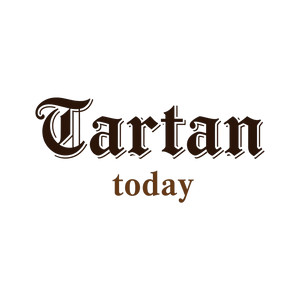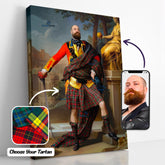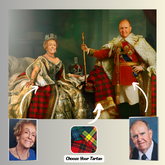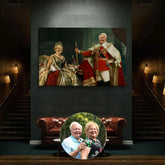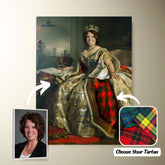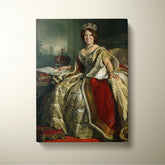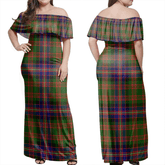-
Personalized Clan Cochrane Modern Tartan Bagpipe Ornament with Custom Name – Scottish Christmas Tree Decoration TE92
Personalized Clan Cochrane Modern Tartan Bagpipe Ornament with Custom Name – Scottish Christmas Tree Decoration TE92Celebrate your Scottish heritage with this unique wood & acrylic tartan ornament. Perfect as a personalized Christmas decoration or a meaningful gift for friends and relatives on special occasions...- From $19.99 USD
$25.99 USD- From $19.99 USD
- Unit price
- per
Save $6.00 -
Personalized Clan Cochrane Ancient Tartan Bagpipe Ornament with Custom Name – Scottish Christmas Tree Decoration IF73
Personalized Clan Cochrane Ancient Tartan Bagpipe Ornament with Custom Name – Scottish Christmas Tree Decoration IF73Celebrate your Scottish heritage with this unique wood & acrylic tartan ornament. Perfect as a personalized Christmas decoration or a meaningful gift for friends and relatives on special occasions...- From $19.99 USD
$25.99 USD- From $19.99 USD
- Unit price
- per
Save $6.00 -
Personalized Clan Cochrane (Cochran) Modern Clan Crest Tartan Santa Ornament – Custom Acrylic Christmas Decoration QA79 - Cochrane
Personalized Clan Cochrane (Cochran) Modern Clan Badge Tartan Ornament – Custom Acrylic Christmas Decoration QA79Celebrate your Scottish heritage with this unique wood & acrylic tartan ornament. Perfect as a personalized Christmas decoration or a meaningful gift for friends and relatives on special occasions such...- From $19.99 USD
- From $19.99 USD
- Unit price
- per
-
Cochrane
-
Clan Cochrane Modern Tartan Crest Heart Ceramic Ornament HJ82 - Cochrane Modern Tartan
Clan Cochrane Modern Tartan Crest Heart Ceramic Ornament HJ82 One of the best things about Christmas is that it gives you an excuse to dress up your home with all of the lovely ornaments we associate with the holiday season. With so many different...- From $19.25 USD
- From $19.25 USD
- Unit price
- per
-
Cochrane Modern Tartan
-
Clan Cochrane Modern Tartan Hawaii Dress BY36 - Cochrane Modern Tartan
Cochrane Modern Tartan Clan Hawaii Dress BY36 Product detail: All of our Midi Dresses are custom-made-to-order and handcrafted to the highest quality standards. Made of polyester/spandex material for a perfect fit. Anti-Static, Anti-wrinkle, Breathable, Lightweight ideal for Spring and Summer fun. Each Dress is...- $54.25 USD
- $54.25 USD
- Unit price
- per
-
Cochrane Modern Tartan
-
Personalized Clan Cochrane Modern Tartan Drummer Ornament with Custom Name – Scottish Christmas Tree Decoration MA41
Personalized Clan Cochrane Modern Tartan Drummer Ornament with Custom Name – Scottish Christmas Tree Decoration MA41Celebrate your Scottish heritage with this unique wood & acrylic tartan ornament. Perfect as a personalized Christmas decoration or a meaningful gift for friends and relatives on special occasions...- From $19.99 USD
$25.99 USD- From $19.99 USD
- Unit price
- per
Save $6.00 -
Personalized Clan Cochrane Ancient Tartan Drummer Ornament with Custom Name – Scottish Christmas Tree Decoration IC67
Personalized Clan Cochrane Ancient Tartan Drummer Ornament with Custom Name – Scottish Christmas Tree Decoration IC67Celebrate your Scottish heritage with this unique wood & acrylic tartan ornament. Perfect as a personalized Christmas decoration or a meaningful gift for friends and relatives on special occasions...- From $19.99 USD
$25.99 USD- From $19.99 USD
- Unit price
- per
Save $6.00 -
Personalized Clan Cochrane Reproduction Tartan Bagpipe Ornament with Custom Name – Scottish Christmas Tree Decoration CR59
Personalized Clan Cochrane Reproduction Tartan Bagpipe Ornament with Custom Name – Scottish Christmas Tree Decoration CR59Celebrate your Scottish heritage with this unique wood & acrylic tartan ornament. Perfect as a personalized Christmas decoration or a meaningful gift for friends and relatives on special occasions...- From $19.99 USD
$25.99 USD- From $19.99 USD
- Unit price
- per
Save $6.00 -
Personalized Clan Cochrane Hunting Reproduction Tartan Bagpipe Ornament with Custom Name – Scottish Christmas Tree Decoration FZ97
Personalized Clan Cochrane Hunting Reproduction Tartan Bagpipe Ornament with Custom Name – Scottish Christmas Tree Decoration FZ97Celebrate your Scottish heritage with this unique wood & acrylic tartan ornament. Perfect as a personalized Christmas decoration or a meaningful gift for friends and relatives on special...- From $19.99 USD
$25.99 USD- From $19.99 USD
- Unit price
- per
Save $6.00 -
Personalized Clan Cochrane Hunting Modern Tartan Bagpipe Ornament with Custom Name – Scottish Christmas Tree Decoration YC50
Personalized Clan Cochrane Hunting Modern Tartan Bagpipe Ornament with Custom Name – Scottish Christmas Tree Decoration YC50Celebrate your Scottish heritage with this unique wood & acrylic tartan ornament. Perfect as a personalized Christmas decoration or a meaningful gift for friends and relatives on special...- From $19.99 USD
$25.99 USD- From $19.99 USD
- Unit price
- per
Save $6.00 -
Personalized Clan Cochrane Hunting Ancient Tartan Bagpipe Ornament with Custom Name – Scottish Christmas Tree Decoration FV57
Personalized Clan Cochrane Hunting Ancient Tartan Bagpipe Ornament with Custom Name – Scottish Christmas Tree Decoration FV57Celebrate your Scottish heritage with this unique wood & acrylic tartan ornament. Perfect as a personalized Christmas decoration or a meaningful gift for friends and relatives on special...- From $19.99 USD
$25.99 USD- From $19.99 USD
- Unit price
- per
Save $6.00 -
Personalized Clan Cochrane Azure Reproduction Tartan Bagpipe Ornament with Custom Name – Scottish Christmas Tree Decoration HK56
Personalized Clan Cochrane Azure Reproduction Tartan Bagpipe Ornament with Custom Name – Scottish Christmas Tree Decoration HK56Celebrate your Scottish heritage with this unique wood & acrylic tartan ornament. Perfect as a personalized Christmas decoration or a meaningful gift for friends and relatives on special...- From $19.99 USD
$25.99 USD- From $19.99 USD
- Unit price
- per
Save $6.00 -
Personalized Clan Cochrane Azure Modern Tartan Bagpipe Ornament with Custom Name – Scottish Christmas Tree Decoration IX89
Personalized Clan Cochrane Azure Modern Tartan Bagpipe Ornament with Custom Name – Scottish Christmas Tree Decoration IX89Celebrate your Scottish heritage with this unique wood & acrylic tartan ornament. Perfect as a personalized Christmas decoration or a meaningful gift for friends and relatives on special...- From $19.99 USD
$25.99 USD- From $19.99 USD
- Unit price
- per
Save $6.00 -
Personalized Clan Cochrane Azure Ancient Tartan Bagpipe Ornament with Custom Name – Scottish Christmas Tree Decoration CY18
Personalized Clan Cochrane Azure Ancient Tartan Bagpipe Ornament with Custom Name – Scottish Christmas Tree Decoration CY18Celebrate your Scottish heritage with this unique wood & acrylic tartan ornament. Perfect as a personalized Christmas decoration or a meaningful gift for friends and relatives on special...- From $19.99 USD
$25.99 USD- From $19.99 USD
- Unit price
- per
Save $6.00 -
Personalized Clan Cochrane Ancient Tartan Bagpipe Ornament with Custom Name – Scottish Christmas Tree Decoration SF38
Personalized Clan Cochrane Ancient Tartan Bagpipe Ornament with Custom Name – Scottish Christmas Tree Decoration SF38Celebrate your Scottish heritage with this unique wood & acrylic tartan ornament. Perfect as a personalized Christmas decoration or a meaningful gift for friends and relatives on special occasions...- From $19.99 USD
$25.99 USD- From $19.99 USD
- Unit price
- per
Save $6.00 -
Personalized Clan Cochrane Ancient Tartan Bagpipe Ornament with Custom Name – Scottish Christmas Tree Decoration RC96
Personalized Clan Cochrane Ancient Tartan Bagpipe Ornament with Custom Name – Scottish Christmas Tree Decoration RC96Celebrate your Scottish heritage with this unique wood & acrylic tartan ornament. Perfect as a personalized Christmas decoration or a meaningful gift for friends and relatives on special occasions...- From $19.99 USD
$25.99 USD- From $19.99 USD
- Unit price
- per
Save $6.00 -
Personalized Clan Cochrane (Cochran) Modern Clan Crest Tartan Santa Ornament – Custom Acrylic Christmas Decoration ZR32 - Cochrane
Personalized Clan Cochrane (Cochran) Modern Clan Badge Tartan Ornament – Custom Acrylic Christmas Decoration ZR32Celebrate your Scottish heritage with this unique wood & acrylic tartan ornament. Perfect as a personalized Christmas decoration or a meaningful gift for friends and relatives on special occasions such...- From $19.99 USD
- From $19.99 USD
- Unit price
- per
-
Cochrane
-
Personalized Clan Cochrane (Cochran) Ancient Clan Crest Tartan Santa Ornament – Custom Acrylic Christmas Decoration VH67 - Cochrane
Personalized Clan Cochrane (Cochran) Ancient Clan Badge Tartan Ornament – Custom Acrylic Christmas Decoration VH67Celebrate your Scottish heritage with this unique wood & acrylic tartan ornament. Perfect as a personalized Christmas decoration or a meaningful gift for friends and relatives on special occasions such...- From $19.99 USD
- From $19.99 USD
- Unit price
- per
-
Cochrane
-
Personalized Clan Cochrane (Cochran) Weathered Clan Crest Tartan Santa Ornament – Custom Acrylic Christmas Decoration TU13 - Cochrane
Personalized Clan Cochrane (Cochran) Weathered Clan Badge Tartan Ornament – Custom Acrylic Christmas Decoration TU13Celebrate your Scottish heritage with this unique wood & acrylic tartan ornament. Perfect as a personalized Christmas decoration or a meaningful gift for friends and relatives on special occasions such...- From $19.99 USD
- From $19.99 USD
- Unit price
- per
-
Cochrane
-
Clan Cochrane Modern Tartan Crest Rug – Scottish Highland Carpet for Living Room, Celtic Home Decor & Scotland Gift HE82
Clan Cochrane Modern Tartan Crest Rug – Scottish Highland Carpet for Living Room, Celtic Home Decor & Scotland Gift HE82Bring timeless Scottish charm into your home with our premium Tartan Area Rug. Designed with authentic Scottish tartan patterns, this rug is perfect for adding...- From $58.45 USD
- From $58.45 USD
- Unit price
- per
Ex: Your Tartan + Product
Popular Products
Turn Me Royal Personalized Portrait from Your Photo, Custom Tartan. Custom Canvas Wall Art as Gift for Men
- From $32.45 USD
- From $32.45 USD
- Unit price
- / per
Royalty Couple Personalized Portrait from Your Photo, Custom Tartan. Custom Canvas Wall Art
- From $47.45 USD
- From $47.45 USD
- Unit price
- / per
The Queen Personalized Portrait from Your Photo, Custom Tartan. Custom Canvas Wall Art as Gift for Women
- From $32.45 USD
- From $32.45 USD
- Unit price
- / per
Which Clan Are You From?
- Apron
- Cochrane
- Cochrane (Cochran) Ancient
- Cochrane (Cochran) Modern
- Cochrane (Cochran) Weathered
- Cochrane 01
- Cochrane 02
- Cochrane 03
- Cochrane Ancient
- Cochrane Ancient Tartan
- Cochrane Ancient Tartan
- Cochrane Azure
- Cochrane Azure Ancient
- Cochrane Azure Modern
- Cochrane Azure Reproduction
- Cochrane Hunting
- Cochrane Hunting Ancient
- Cochrane Hunting Modern
- Cochrane Hunting Reproduction
- Cochrane Modern
- Cochrane Modern Tartan
- Cochrane Reproduction
- Cochrane Tartan
- Cochrane Tartan Clan
- Scott
List Of Tartan
-
Clan A
- Abercrombie Tartan
- Aberdeen Tartan
- Abernethy Tartan
- Adair Tartan
- Adam Tartan
- Ayrshire Tartan
- Agnew Tartan
- Aikenhead Tartan
- Ainslie Tartan
- Aiton Tartan
- Allan Tartan
- Alexander Tartan
- Allardice Tartan
- Allison Tartan
- Anderson Tartan
- Angus Tartan
- Anstruther Tartan
- Arbuthnot Tartan
- Armstrong Tartan
- Arnott Tartan
- Auchinleck Tartan
- Ayrshire Tartan
-
Clan B
- Baillie Tartan
- Bain Tartan
- Baird Tartan
- Balfour Tartan
- Bannatyne Tartan
- Bannerman Tartan
- Barclay Tartan
- Baxter Tartan
- Beaton Tartan
- Bell Tartan
- Belshes Tartan
- Bethune Tartan
- Beveridge Tartan
- Binning Tartan
- Bisset Tartan
- Blackadder Tartan
- Blackstock Tartan
- Black Watch Tartan
- Blair Tartan
- Blane Tartan
- Blyth Tartan
- Borthwick Tartan
- Boswell Tartan
- Bowie Tartan
- Boyd Tartan
- Boyle Tartan
- Brisbane Tartan
- Brodie Tartan
- Brown/ Broun Tartan
- Bruce Tartan
- Buccleuch Tartan
- Buchan Tartan
- Buchanan Tartan
- Burnett Tartan
- Burns Tartan
- Butter Tartan
- Byres Tartan
-
Clan C
- Cairns Tartan
- Calder Tartan
- Callander Tartan
- Cameron Tartan
- Campbell Tartan
- Campbell of Breadalbane Tartan
- Campbell of Cawdor Tartan
- Carmichael Tartan
- Carnegie Tartan
- Carruthers Tartan
- Cathcart Tartan
- Chalmers Tartan
- Charteris Tartan
- Chattan Tartan
- Cheyne Tartan
- Chisholm Tartan
- Christie Tartan
- Clark Tartan
- Clelland Tartan
- Clephan Tartan
- Clergy Tartan
- Cochrane Tartan
- Cockburn Tartan
- Colquhoun Tartan
- Colville Tartan
- Cooper Tartan
- Couper Tartan
- Craig Tartan
- Cranstoun Tartan
- Crawford Tartan
- Crichton Tartan
- Crief District Tartan
- Crosbie Tartan
- Cumming Tartan
- Cunningham Tartan
- Currie Tartan
- Clan D
- Clan E
- Clan F
- Clan G
- Clan H
- Clan I
- Clan J
- Clan K
- Clan L
-
Clan M
- Maitland Tartan
- Malcolm Tartan
- Mar Tartan
- Marjoribanks Tartan
- Maxtone Tartan
- Matheson Tartan
- Maule Tartan
- Maxwell Tartan
- Meldrum Tartan
- Melville Tartan
- Menzies Tartan
- Mercer Tartan
- Middleton Tartan
- Moffat Tartan
- Moncrieffe Tartan
- Montgomery Tartan
- Monypenny Tartan
- Moncreiffe Tartan
- Monteith Tartan
- Morrison Tartan
- Mouat Tartan
- Moubray Tartan
- Mow Tartan
- Muir_More Tartan
- Muirhead Tartan
- Munro Tartan
- Murray Tartan
- Murray of Atholl Tartan
-
Clan Mc/Mac
- MacAlister Tartan
- MacArthur Tartan
- MacAlpine Tartan
- MacAulay Tartan
- MacBain Tartan
- MacBean Tartan
- MacBeth Tartan
- MacCallum Tartan
- MacCraig Tartan
- MacColl Tartan
- MacCorquodale Tartan
- MacDiarmid Tartan
- MacDonald Tartan
- MacDonald of Clanranald Tartan
- MacDonald of Sleat Tartan
- MacDonnell of Glengarry Tartan
- MacDonnell of Keppoch Tartan
- MacDougall Tartan
- MacDowall Tartan
- MacDuff Tartan
- MacEwen_MacEwan Tartan
- MacEdward Tartan
- MacFarlane Tartan
- MacGill Tartan
- MacGillivray Tartan
- MacGregor Tartan
- MacGowan (McGowan) Tartan
- MacHardy Tartan
- MacIan Tartan
- MacInnes Tartan
- MacIntyre Tartan
- MacKay Tartan
- MacKillop Tartan
- MacKellar Tartan
- Mackinlay Tartan
- MacKenzie Tartan
- Mackie Tartan
- MacKinnon Tartan
- MacKintosh / MacIntosh Tartan
- MacLeod Tartan
- MacMillan Tartan
- MacNab Tartan
- MacNaughton Tartan
- MacNeil / MacNeill Tartan
- MacNeil of Colonsay Tartan
- MacNicol Tartan
- MacPhail Tartan
- MacPhee_MacFie Tartan
- MacPherson Tartan
- MacQuarrie Tartan
- MacQueen Tartan
- MacRae Tartan
- MacRow Tartan
- MacSporran Tartan
- MacTaggart Tartan
- MacTavish Tartan
- MacThomas Tartan
- McCorquodale Tartan
- McCulloch Tartan
- McFadzen Tartan
- McGeachie Tartan
- McIver Tartan
- McKerrell Tartan
- Clan N
- Clan O
- Clan P
- Clan R
-
Clan S
- Sandilands Tartan
- Scott Tartan
- Scrymgeour Tartan
- Selkirk Tartan
- Sempill Tartan
- Seton Tartan
- Shaw Tartan
- Shepherd Tartan
- Sinclair Tartan
- Skene Tartan
- Skirving Tartan
- Smith Tartan
- Somerville Tartan
- Spalding Tartan
- Spens Tartan
- Spottiswood Tartan
- Stevenson Tartan
- Stewart Tartan
- Stewart of Appin Tartan
- Stirling Tartan
- Strachan Tartan
- Straiton Tartan
- Strange Tartan
- Strathclyde District Tartan
- Stuart of Bute Tartan
- Sutherland Tartan
- Swinton Tartan
- Clan T
- Clan U W Y
- Request Your Clan
Clan Cochrane (Cochrane Tartan)
1. About Clan Cochrane
2. Cochrane Clan history
This family's ancestry is said to have started with a Viking warrior who chose to live in Renfrewshire in the ninth century. The origin of the name this Viking's descendants adopted is the subject of several hypotheses.
An early family member was referred to be a "brave fellow" by his master after engaging in such fierce combat. He would have called him "coch ran" in the Gaelic they both spoke. Cochrane originates from yet another Gaelic twisting of the phrases "battle cry" or "the roar of battle."
A Cochrane warrior who killed three wild boars that were terrorizing the region is represented by the three boars that were discovered on the chief's shield.
Auchindoun Castle, Moray, was built by Thomas Cochrane in the mid-15th century
Allan Cochrane of Cochrane obtained his father Robert's resignation of the Cochrane lands in 1456.
After that, James II granted him a charter for the lands. Before he passed away in 1594, William Cochrane of that ilk had the manor house expanded with a tower.
Cochrane Castle was its previous name.
When early 1600s William Cochrane of that ilk having no sons, the chiefship was under risk.
He made sure that whoever married his daughter Elizabeth was legally obligated to take the Cochrane name and coat of arms as their own. William's descendant and heir, the first Earl of Dundonald, assumed office in 1669.
The 'warrior Cochranes,' a family of leaders who continually served their country valiantly on land and at sea, were actually started by Elizabeth's eldest son Alexander, who rose to become a colonel for Charles I.
The most well-known of these was Thomas, the ninth Earl, who in 1801, under the command of a brig and just fifty-four men, boarded and seized a Spanish frigate with thirty-two heavy guns and three hundred and ninety-nine crew.
3. Cochrane Clan Tartans
The Cochrane tartan is supposed to have originated from a portrait, but in 1974, the 14th Earl of Dundonald modified the pattern to only feature three groups of the four red lines.
The sett was then modified back to the original groupings of four red lines in 1984 by the 15th Earl of Dundonald. The historic Lochaber region, which served as a base for the MacDonald and the Cameron of Erracht, is the inspiration for the tartan sett.
While "modern" refers to deeper colors, "ancient" relates to dye tones, which are typically lighter.
G/68 R8 G6 R4 G8 R4 G6 R8 G34 K34 R4 B34 R8 B8 Y/6 Threadcount
Cochrane Ancient
Cochrane Modern
4. Clan Cochrane Crest & Coats of Arms
4.1 Clan Cochrane Crest
Worn by all of the name and ancestry
Crest Description:
A horse passant, Argent
4.2 Clan Cochrane Coat of Arms
Note on Coats of Arms: A coat of arms is given to an individual under Scottish heraldic law (with the exception of civic or corporate arms). A 'family coat of arms' does not exist.
With the exclusions listed above, the weapons depicted below are personal weapons. The only person authorized to use these weapons is the grantee.
COCHRANE (plain)
A chevron in Gules between three erased boar heads in Azure.
William Cochrane's coat of arms in stone. mounted on a contemporary tower close to Johnstone, a town in Renfrewshire. Early in the 1100s, the Cochrane family moved onto their own estates.
a picture of Thomas Cochrane, the 10th Earl of Dundonald,'s tomb marker in Westminster Abbey
USS Cochrane Command Seal
5. Clan Cochrane Places & People
5.1 Clan Cochrane People
5.1.1 Andrew James Cochrane-Johnstone (1767-1833)
While serving as Governor of St. Dominica, Andrew James Cochrane-Johnstone committed crimes such as dictatorship, extortion, slave trading, running guns, and pimping before becoming an MP.
After serving in the Parliament, he masterminded a massive stock exchange fraud in 1814.
Just before a "French Royalist" arrived at Dover bearing the wonderful news that Napoleon had died, Cochrane and his criminal associates made large purchases on the Stock Exchange.
Cochrane sold off all of his government stocks at higher prices as they rose in value. The market crashed when the 'French Royalist' disappeared. When Cochrane's involvement in the fraud was discovered, he also disappeared to Europe.
At the time, Captain Lord Thomas Cochrane, his excellent nephew, was accused of conspiring with Cochrane. Despite his blatant innocence, his political adversaries took full advantage of the situation.
5.1.2 Admiral Sir Thomas Cochrane, 10th Earl of Dundonald, Marquess do Maranhão, GCB, ODM (Chile) (14 Dec. 1775 – 31 Oct. 1860)
Archibald Cochrane, the 9th Earl of Dundonald, and Anna Gilchrist welcomed Thomas Cochrane into the world in Annsfield, a town close to Hamilton in South Lanarkshire. His early years were largely spent in Culross, a coastal village in Fife.
Thomas was referred to as Lord Cochrane from 1778 until the passing of his father in 1831; following the passing, he was given the title Earl of Dundonald.
Thomas was noted in the novels as having served as a crew man on four Royal Navy ships beginning at the age of five thanks to the influence of his uncle, Alexander Cochrane.
A very illustrious career in the Royal Navy was about to begin at this young age.
Thomas married Katherine Francis Corbet Barnes, an orphan and well-known beauty, in 1812 despite her being more than 20 years his junior.
They had six kids collectively. Cochrane developed a reputation as an aggressive, risk-taking, and effective Captain during the Napoleonic Wars, earning him the nickname "Wolf of the Seas" from the French Navy.
However, Lord Cochrane was expelled from the Royal Navy in 1814 due to allegations of stock exchange fraud.
As a result, he turned to mercenary work and joined the rebel ships of Chile, Brazil, and Greece in their separate independence struggles. The Order of Merit he was awarded came from Chile.
In the Royal Navy once more by 1832, Cochrane had the position of Rear Admiral of the Blue.
Cochrane had numerous promotions over the remainder of his naval career before retiring with the honorary rank of Rear Admiral of the United Kingdom and the rank of Rear Admiral of the Red just a few years before his untimely death.
Thomas Cochrane, the 10th Earl of Dundonald, passed away at the age of 84 on October 31st, 1860, while having surgery for kidney stones.
His career and achievements in the navy served as an influence for nautical fiction written in the 19th and 20th centuries, particularly Horatio Hornblower by C.S. Forester and Jack Aubrey by Patrick O'Brian.
5.1.3 Captain John Dundas Cochrane (1793-1825) - main image
The son of Andrew James Cochrane-Johnstone attempted to walk around the world after making contributions during the Napoleonic Wars.
He sought to determine whether there was a land bridge connecting Russia and Alaska and whether there was a North-West passage over America by using a horse-drawn sled as little as possible.
Eighty-three days after leaving Dieppe, he arrived in St. Petersburg having been robbed of everything but two waistcoats.
He finished the final 96 miles in thirty-two hours while traveling to Moscow while wearing one as a kilt.
He spent a 20-night stretch trudging in the snow while in excruciating bodily pain while walking along the Arctic coast, "without even the comfort of a blanket - a great oversight."
He fell in love and wed a 14-year-old Kamchatka girl while attempting to obtain permission to cross the Baring Straight, with half the globe having already walked.
He transported her from St. Petersburg all the way across Russia and back to London by sea. His travels were written about and sold well.
He developed a fever and passed away while visiting his cousin Charles Stuart Cochrane's copper mining enterprise in Columbia.
5.1.4 Captain Charles Stuart Cochrane b.1796
The second son of Admiral Sir Alexander Cochrane, also known as "Senior Jean de Vega, a Spanish minstrel," was born on HMS Thetis, a ship that at the time carried five Cochranes.
Having fought in the Napoleonic Wars, he left the Navy to go copper mining up the Magdalena River into Columbia.
After traveling throughout Europe as a result of the unsuccessful effort, he returned to Britain in 1828.
He spent that year and the following one traveling the nation with a guitar while posing as a Spanish troubadour.
He was referred to be "a little cracked" in Edinburgh, where he eventually made himself known.
When he filed for a patent in France on a device for spinning Cashmere, a wool that was new to the western world, he demonstrated that he was totally able-minded.
To accommodate the demand for spun Tibetan goats' beard, he constructed a mill in Glasgow for his machines.
In "Journal of a Tour Made by Senor Jean de Vega, a Spanish Minstrel of 1828-29 Through Great Britain and Ireland," he chronicled his exploits.
6. Associated Names
'de Coueran' was recognized as the name. Formerly mentioned as a sept of Clan Donalds, Cochrane is no longer.
7. Unraveling the Intriguing Story of Clan Cochrane and the Enigmatic Cochrane Tartan
7.1 Origins of Clan Cochrane
The roots of Clan Cochrane can be traced back to the ancient lands of Renfrewshire in Scotland. The Cochranes, like many other Scottish clans, can be linked to a specific progenitor.
The clan's history commences with the arrival of a Norman knight named Sir Percy de Coueran.
Sir Percy settled in Scotland during the reign of King David I in the 12th century and adopted the name Cochrane, derived from "Cochrane Castle" where he made his residence.
7.2 The Rise of Clan Cochrane and Their Chieftains
In the early years of their existence, Clan Cochrane served as loyal vassals to the High Stewards of Scotland, who later became the royal Stuart dynasty.
The Cochranes gained prominence through their military prowess and steadfast loyalty to the crown.
Sir John Cochrane, the second Laird of Cochrane, played a significant role in the Wars of Scottish Independence, fighting alongside legendary figures such as William Wallace and Robert the Bruce.
7.3 The Ascendancy of the Cochrane Earls
Over the centuries, Clan Cochrane rose in influence and power, ultimately producing several prominent figures who attained the title of Earl.
One of the clan's notable chieftains was William Cochrane, the 1st Earl of Dundonald, who played a crucial role in shaping Scotland's naval history.
The Cochrane family's connection to the sea led to their involvement in maritime affairs, with Admiral Thomas Cochrane, the 10th Earl of Dundonald, leaving an indelible mark as one of Britain's most celebrated naval commanders.
7.4 Territories and Influence of Clan Cochrane
Cochrane Castle
Situated in the heart of Renfrewshire, Cochrane Castle served as the ancestral seat of the Cochranes and formed the nucleus of their territorial domain.
The castle, now in ruins, stands as a testament to the clan's historical significance in the region. Today, the site serves as a reminder of Clan Cochrane's once mighty stronghold.
Renfrewshire and Ayrshire
Renfrewshire and Ayrshire were the primary territories owned and controlled by Clan Cochrane. Through their alliances, military prowess, and strategic marriages, the Cochranes expanded their influence and acquired vast tracts of land.
These territories provided the clan with economic prosperity and a strategic foothold in southwest Scotland.
Connections and Alliances
Clan Cochrane, like other Scottish clans, formed alliances with neighboring clans for mutual defense and diplomatic purposes.
The Cochranes had connections with clans such as the Montgomeries, the Campbells, and the Stewarts of Appin, further enhancing their sphere of influence and establishing themselves as formidable players in Scottish affairs.
7.5 The Enigmatic Cochrane Tartan and Its Symbolism
Design and Colors
The Cochrane Tartan, a distinctive pattern of colors and lines, is steeped in symbolism and represents the rich heritage of Clan Cochrane. The tartan features a combination of red, navy blue, black, and white, woven together in a mesmerizing pattern.
The vibrant red symbolizes courage and loyalty, while the navy blue represents the sea, paying homage to the clan's naval connections. The black and white lines represent the enduring strength and honor of the Cochrane clan.
Tartan Variations and Their Significance
Within the Cochrane Tartan family, several variations exist, each carrying its own unique meaning and historical context.
The variations include the Dress Cochrane Tartan, predominantly worn for formal occasions, and the Ancient Cochrane Tartan, which harkens back to the clan's early days.
These variations allow clan members to showcase their pride and connection to their heritage through the choice of tartan they don.
7.6 The Enduring Legacy of Clan Cochrane
Through centuries of turbulent history and political upheavals, Clan Cochrane has managed to preserve its legacy and make enduring contributions to Scottish culture.
The spirit of bravery, loyalty, and honor that defined the clan continues to resonate with descendants and enthusiasts worldwide.
The enigmatic Cochrane Tartan serves as a tangible symbol of the clan's enduring heritage, connecting past and present generations.
7.7 Frequently Asked Questions (FAQs)
7.7.1 What is the significance of Clan Cochrane in Scottish history?
Clan Cochrane played a significant role in Scottish history, with their chieftains contributing to the country's naval prowess and serving as loyal vassals to the royal Stuarts.
7.7.2 How can one identify the Cochrane Tartan?
The Cochrane Tartan is recognizable by its vibrant combination of red, navy blue, black, and white, woven together in a distinctive pattern that symbolizes the clan's heritage and values.
7.7.3 Are there any surviving Cochrane castles?
Cochrane Castle, the ancestral seat of the Cochranes, remains in ruins but serves as a reminder of the clan's historical significance. Other castles associated with the clan, such as Dundonald Castle, still stand as well-preserved landmarks.
7.7.4 What is the significance of the navy blue color in the Cochrane Tartan?
The navy blue color in the Cochrane Tartan represents the sea and pays tribute to the clan's involvement in maritime affairs, particularly their achievements in naval battles.
7.7.5 What famous figures emerged from Clan Cochrane?
Admiral Thomas Cochrane, the 10th Earl of Dundonald, achieved fame as one of Britain's most renowned naval commanders. His strategic brilliance and naval innovations left an indelible mark in history.
7.7.6 Are there any Cochrane Tartan variations available?
Yes, variations such as the Dress Cochrane Tartan, worn for formal occasions, and the Ancient Cochrane Tartan, reflecting the clan's early days, offer options for clan members to display their heritage.
8. Conclusion
The story of Clan Cochrane and the enigmatic Cochrane Tartan is a fascinating journey through Scottish history. From their humble beginnings in Renfrewshire to their rise as influential figures in naval affairs, Clan Cochrane's legacy continues to captivate and inspire.
The Cochrane Tartan serves as a proud symbol of their heritage, connecting past and present generations in a colorful tapestry of Scottish culture.
As we unravel the intriguing story behind Clan Cochrane and their tartan, we come to appreciate the enduring spirit and resilience that define this remarkable clan.
- Choosing a selection results in a full page refresh.
